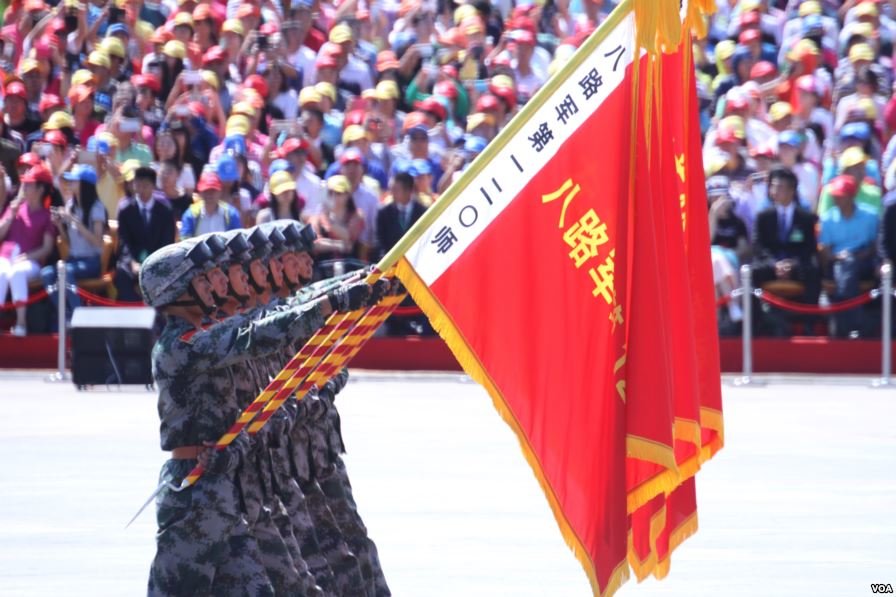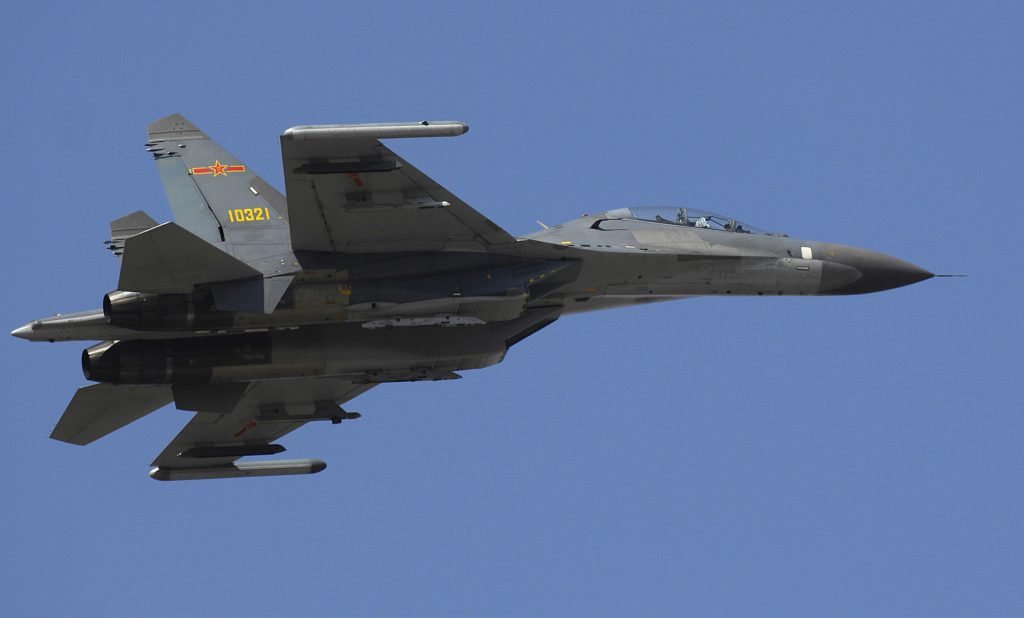Super Soldiers, Weather Control, and Artificial Intelligence — China’s Craziest Technological Advances in 2020

Chinese troops march in the 2020 Moscow Victory Day Parade. Photo by The Presidential Press and Information Office of Russia via Wikimedia Commons.
The common conclusion among America’s military officials and experts is that the US has decidedly entered a new era of great power competition. As the predominant line of thinking goes: The counterinsurgency conflicts that defined the post-9/11 generation of American warriors are steadily receding in importance before novel threats from much more sophisticated near-peer adversaries, such as China and Russia.
America’s 2018 National Security Strategy warned of a new era of “global disorder, characterized by decline in the long-standing rules-based international order — creating a security environment more complex and volatile than any we have experienced in recent memory.”
“Inter-state strategic competition, not terrorism, is now the primary concern in U.S. national security,” the Department of Defense document stated.
China, in particular, has emerged in recent years as a legitimate challenger to US military dominance in the Indo-Pacific region. In the South China Sea, China has been transforming natural atolls into military outposts, ratcheting up an ongoing dispute over freedom of navigation in that body of water.
Thus, in the minds of America’s military leadership, a quiet battle in the larger contest between the US and China for global dominance is currently underway in the Pacific Islands and the South China Sea. According to the Defense Department’s 2019 Indo-Pacific Strategy Report, China “seeks Indo-Pacific regional hegemony in the near-term and, ultimately […] global preeminence in the long-term.”

Overall, Chinese military leaders say their country’s armed forces are in the midst of a “revolution” in military affairs. That so-called revolution includes the advent of new technologies like artificial intelligence and hypersonic weapons, as well as the expansion of China’s nuclear arsenal and advances in spaceflight.
More worryingly, some of Beijing’s newest technological pursuits seem to be drawn from the recesses of science fiction’s most dystopian projections. According to recent reports, China is already seriously pursuing the technology needed to genetically engineer super soldiers, and even to control the weather.
Thus, as 2020 comes to its highly anticipated conclusion, it behooves the American reader to take stock of some of China’s ongoing technological advances, which may have significant national security repercussions. After all, when it comes to artificial intelligence and genetic engineering and controlling the weather — what could possibly go wrong?
Weather Control
Last week China announced plans to rapidly expand an ongoing, experimental weather control program, widening its scope to affect a region in China about 1.5 times the size of India.
According to a statement from Beijing that cites “breakthroughs” in weather control technology, by 2025 China will possess a “developed weather modification system.” That system will moderate the precipitation — both snowfall and rainfall — within an area of about 2.1 million square miles. A smaller portion of land will fall under the purview of so-called hail suppression technology.
Ostensibly, Beijing’s weather control technology is intended to benefit the country’s agricultural output and prevent natural disasters. However, some climate experts have sounded the alarm on Beijing’s experimental program, both for any unintended, long-term effects on the environment, as well as the potential for China to engage in what is tantamount to “rain stealing” from its neighbors — including India, a country with which China has been locked in a decades-long series of deadly skirmishes over a disputed Himalayan frontier.
Some Indian news reports have already accused China of “weaponizing” the weather.

According to news reports, China’s weather modification program is partly focused on the Qinghai-Tibet plateau — a region that serves as the watershed for many of the region’s most important rivers, including the Mekong River and the Brahmaputra River.
“Now, it is emerging that China may be threatening India with weather manipulation,” Sapna Singh, a reporter for the Indian national security news agency, India Sentinels, wrote in July.
“China’s shady activities in Tibet and its attitude to keep others in dark by not sharing data is a big concern for its neighbouring down-river countries, like India,” Singh wrote.
China’s program reportedly revolves around “cloud seeding” technology, in which small amounts of silver iodide are loaded into shells and shot from airplanes into moisture-laden clouds. Water particles then coalesce around the dispersed silver iodide and become precipitation.
China has already reportedly used such technology to clear the skies in advance of the 2008 Beijing Olympics, as well as to clear the air prior to last year’s events to celebrate the 70th anniversary of the People’s Republic of China.
China spent more than $1.34 billion on cloud-seeding technology from 2012 to 2017, according to the Xinhua News Agency, the official state-run press agency of the People’s Republic of China. Using cloud-seeding technology, China produced an additional 233.5 billion cubic meters of rainfall in that period, the Xinhua News Agency reported.
Last year, according to the Xinhua News Agency, China’s weather modification program reduced hail damage by some 70% in the Xinjiang-Uygur autonomous region.
The Guardian reported last week that in 2017 China set aside some $168 million to purchase four new aircraft, upgrade eight other aircraft, and purchase 897 rocket launchers for its cloud-seeding program. The Beijing weather modification office claimed it has increased precipitation in the capital by more than 10%, The Guardian reported.

China has also reportedly installed hundreds of fuel-burning chambers in mountains across the Tibetan plateau to seed the high-altitude region’s atmosphere with silver iodide in a gambit to induce more rainfall on China’s side of the Himalayas.
“This attempt to hydro-engineer the sky could ease shortages in the dry north of China but may exacerbate problems in south-east Asia and India,” The Guardian reported.
“Post-socialist authoritarian China is the world’s leading user of state power for rainfall enhancement through weather modification, with diverse purposes including agriculture production, water security, ecological preservation, and mega events,” wrote the authors of a 2017 National Taiwan University report on China’s weather modification program.
“We argue that weather modification in China needs to be understood as a facet of ecological modernization, in which the authoritarian state believes that precipitation can be controlled through the use of advanced technologies, thus transforming clouds into a kind of cloud water resource,” the Taiwanese researchers said, adding that a “lack of proper coordination of weather modification activity [might] lead to charges of ‘rain stealing’ between neighboring regions.”
Genetically Engineered Super Soldiers
“U.S. intelligence shows that China has even conducted human testing on members of the People’s Liberation Army in hope of developing soldiers with biologically enhanced capabilities,” US Director of National Intelligence John Ratcliffe wrote in a recent op-ed for The Wall Street Journal.
He added: “There are no ethical boundaries to Beijing’s pursuit of power.”

Biological research has also become a priority for China’s military. Researchers from the Chinese military’s Academy of Military Medical Sciences have been engaged in a commercial venture to develop brain-computer interfaces that can be paired with artificial intelligence technology — presumably to give Chinese soldiers a battlefield edge. Chinese scientists have also made recent breakthroughs in a gene editing technique called CRISPR-Cas.
The Academy of Military Medical Sciences has reportedly sanctioned research on how the CRISPR gene editing technology could be used to enhance soldiers’ combat performance. A 2016 doctoral dissertation published by one of the Chinese academy’s researchers cited the “great potential” of the CRISPR gene editing technique as a “military deterrence technology.”
Chinese researchers have also reportedly used the CRISPR gene editing technique to biologically engineer “extra-muscular” dogs for police use, the MIT Technology Review reported in 2015.
Artificial Intelligence
Artificial intelligence, or AI, technology could, in theory, one day divorce human beings from the so-called kill chain of lethal combat operations. And many industry experts say that China is set to become the world’s leader in AI.
To that end, President Xi Jinping of China has made AI technology a national priority, leveraging China’s vast human capital and the power of its centralized form of government in a bid to overtake the US in the development of this burgeoning technological revolution.

In September 2017 Beijing issued a document called the Next Generation Artificial Intelligence Plan, outlining a national effort to jump-start China’s AI technology development.
“In light of new circumstances and demands, we need to take proactive approaches to meet changes, seize the historical opportunity of AI development and take stock of the current situation and make proactive plans to serve socioeconomic development and national security and to lead leapfrog advancement of national competitiveness,” wrote the authors of the Chinese report.
However, some US defense experts have sounded the alarm on China’s so-called crash-course AI development program, warning that in its bid to “leapfrog” the US, China may create dangerous new weapons systems with unintended or unplanned consequences.
“Chinese advances in autonomy and AI-enabled weapons systems could impact the military balance, while potentially exacerbating threats to global security and strategic stability as great power rivalry intensifies,” wrote Elsa Kania, an adjunct senior fellow with the Technology and National Security Program at the Center for a New American Security, in an April 2020 report.
“In striving to achieve a technological advantage, the Chinese military could rush to deploy weapons systems that are unsafe, untested, or unreliable under actual operational conditions,” Kania wrote.

“Carrier-Killer” Missiles
China touts its long-distance so-called carrier-killer missiles as a game changer when it comes to challenging America’s naval dominance in the Pacific Ocean region. To make its point, Beijing test-fired two types of those missiles over the summer — a DF-26B and a DF-21D.
The DF-26B is an intermediate-range ballistic missile with a range of some 2,485 miles and is designed to deliver conventional and nuclear warheads against ground and naval targets. The DF-26B is also able to carry hypersonic glide vehicles, which missile defense systems aboard US ships may not be able to intercept.
Notably, the DF-26B is the first Chinese conventionally armed ballistic missile able to strike Andersen Air Force Base in Guam, as well as other US installations across the eastern Pacific region.
With a range of about 1,000 miles, the DF-21D, colloquially known as the “carrier killer,” is touted by Beijing as the world’s first ballistic missile designed to strike naval targets. Defense experts say the DF-21D is equipped with maneuverable reentry vehicles, which may be able to defeat the missile defense systems aboard US Navy ships.
With its withdrawal last year from the Intermediate-Range Nuclear Forces (INF) Treaty, the US has floated the possibility of deploying ground-based, medium-range missiles to the Indo-Pacific theater — part of a broader effort to push back against China’s rising military footprint in the region.
The US suspended its obligations under the INF treaty in February 2019, claiming that Russia had been developing and deploying missiles in violation of the pact’s limits for years. Moreover, China was never bound by the so-called INF treaty’s missile restrictions — leaving US forces in the Indo-Pacific region at a dangerous disadvantage. Notably, China’s DF-26B and DF-21D missiles would have both fallen within the INF treaty’s proscribed operational ranges.
Consequently, some experts say the US decision to pull out of the pact was also intended to not let China gain an advantage over American forces operating in the Pacific Ocean and South China Sea.

BRCC and Bad Moon Print Press team up for an exclusive, limited-edition T-shirt design!
BRCC partners with Team Room Design for an exclusive T-shirt release!
Thirty Seconds Out has partnered with BRCC for an exclusive shirt design invoking the God of Winter.
Lucas O'Hara of Grizzly Forge has teamed up with BRCC for a badass, exclusive Shirt Club T-shirt design featuring his most popular knife and tiomahawk.
Coffee or Die sits down with one of the graphic designers behind Black Rifle Coffee's signature look and vibe.
Biden will award the Medal of Honor to a Vietnam War Army helicopter pilot who risked his life to save a reconnaissance team from almost certain death.
Ever wonder how much Jack Mandaville would f*ck sh*t up if he went back in time? The American Revolution didn't even see him coming.
A nearly 200-year-old West Point time capsule that at first appeared to yield little more than dust contains hidden treasure, the US Military Academy said.












